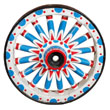The Charging Tiger Tableau / Ticket Wagon
The exact origin of this wagon is unknown but it is believed to have found it’s beginnings on a show owned by Jerry Mugivan and Bert Bowers. Several drop frame style wagons were built with paintings to adorn the sides. That allowed the loading of cargo in the closed Tableau wagon. The earliest known photo of this wagon comes from a 1921 photo taken on the John Robinson Circus.
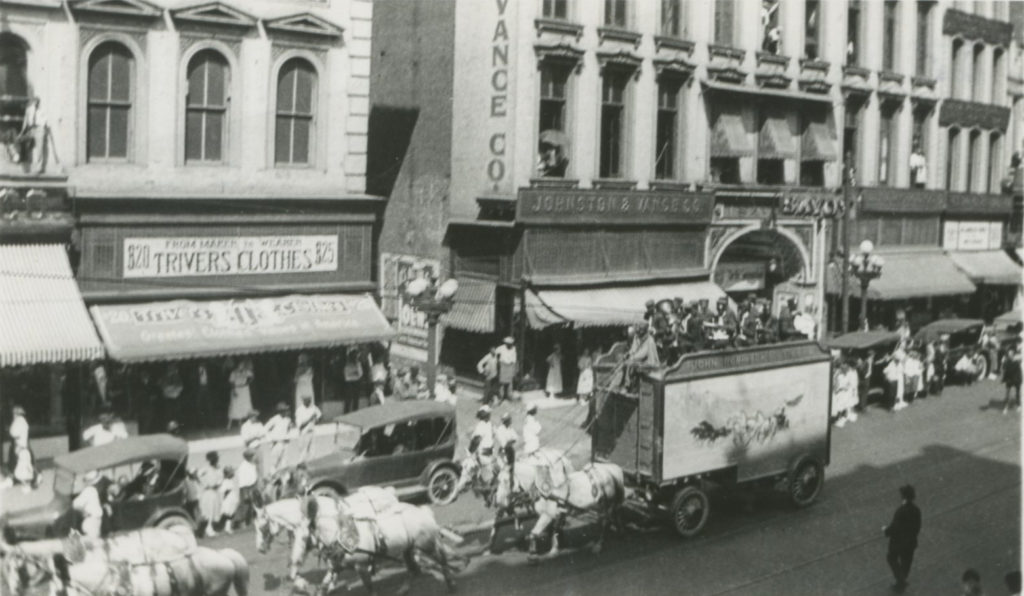 ( 1921 – Conover Set # 827 – photo # 231 – Ralph Miller Collection )
( 1921 – Conover Set # 827 – photo # 231 – Ralph Miller Collection )
The 1921 image shows the racing horses and chariots painting on the side of the wagon. The skyboard is a dark color with the John Robinson Circus lettering. A 1922 photo shows the same painting on the side but the skyboard is now a light color with the John Robinson Circus lettering. In 1924, the wagon was still on the John Robinson Circus, but the painted side had a different design on it then. Also the four corners of both sides were enhanced with a short corner gusset carving.
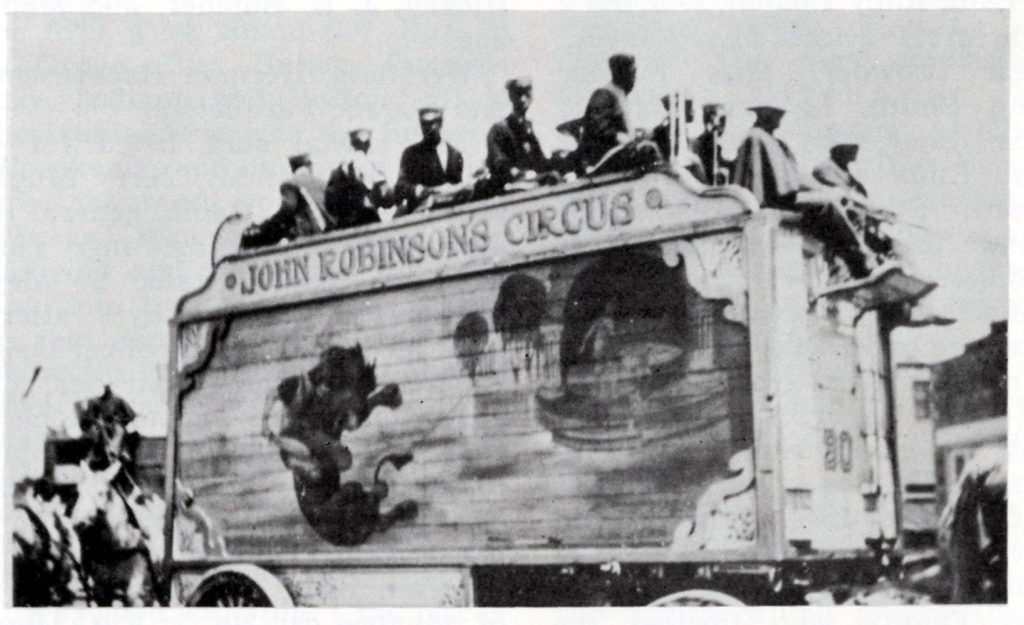 ( 1924 – Joe Fleming photo )
( 1924 – Joe Fleming photo )
The wagon continued to be used on the John Robinson Circus through it’s final year of 1930. The wagon was then transferred over to the Hagenbeck-Wallace Circus. It is not certain if the wagon paintings changed between 1924 and 1930. In 1930, the wagon was carrying # 26 on the front.
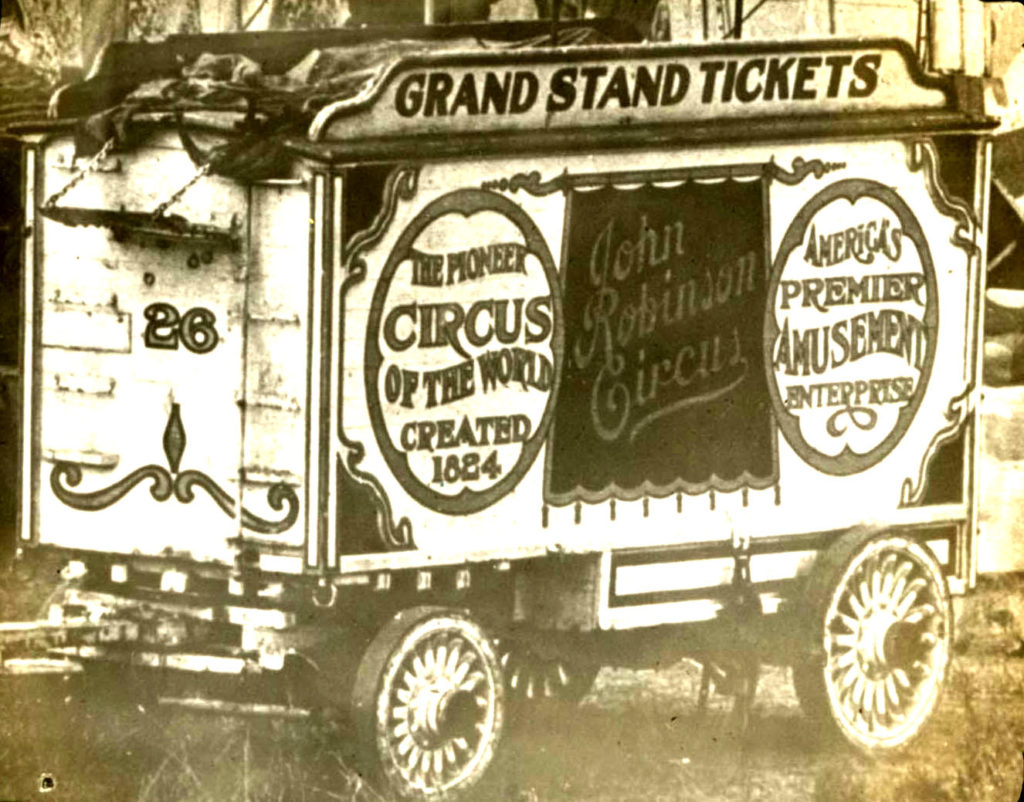 ( 1930 – Joseph Bradbury Album # 9 – photo # 92B – Aug. 20, 1930 in Independence, KS. )
( 1930 – Joseph Bradbury Album # 9 – photo # 92B – Aug. 20, 1930 in Independence, KS. )
With the closing of the John Robinson Circus by John Ringling at the close of the 1930 season, the Hagenbeck-Wallace Circus had more equipment than ever to pick from for their 1931 outing. This wagon became the Grand Stand Ticket Wagon. The wagon number was changed to # 41. The sides were lettered for the Hagenbeck-Wallace Circus with no need for the pictorials it had carried for many years.
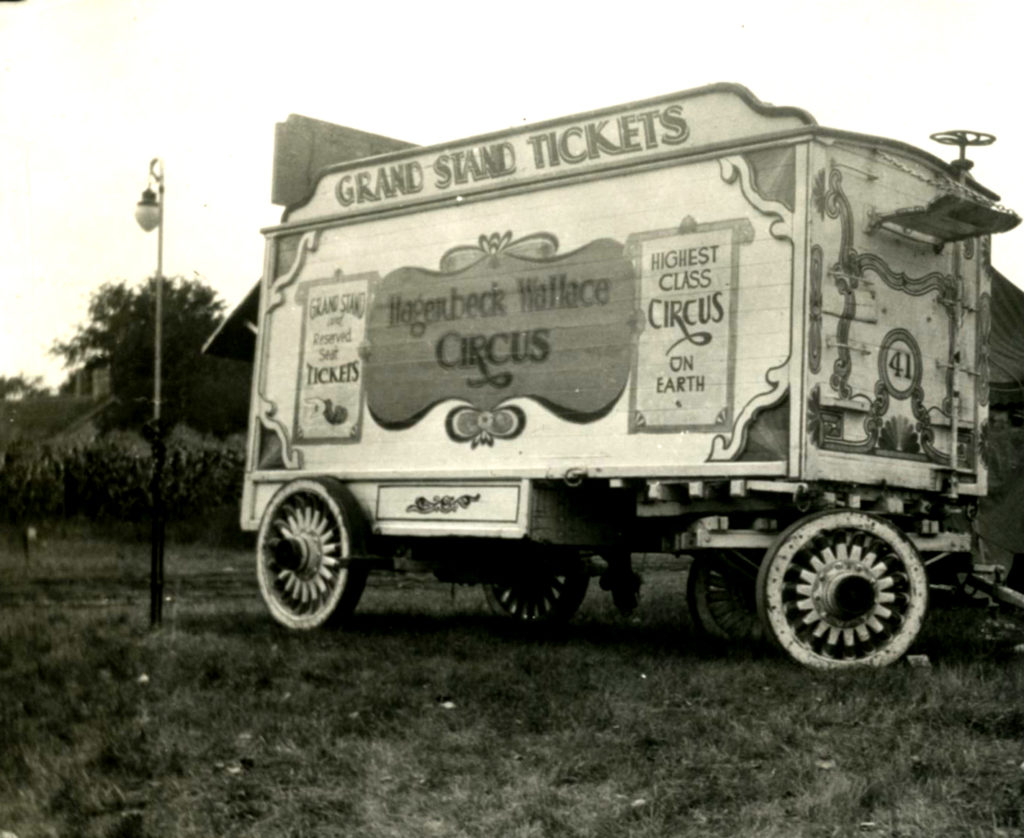 ( 1931 – Joseph Bradbury Album # 31 – photo # 26C )
( 1931 – Joseph Bradbury Album # 31 – photo # 26C )
Following the close of the 1931 season, this wagon went back to the Paint shops in the Peru winter quarters where it was re-decorated with the images of Carl Hagenbeck and Ben Wallace adorning the sides.
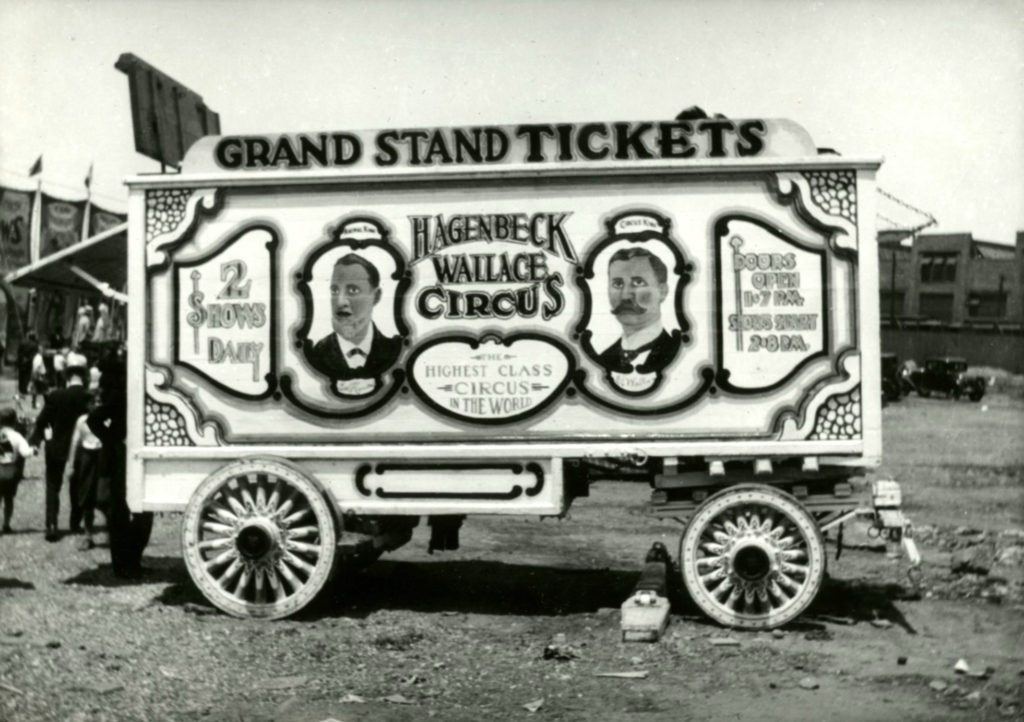 ( 1932 – Joseph Bradbury Album # 47 – photo # 24B – June 6-11, 1932 in Brooklyn, NY – Warren H. Wood photo via Buster Bailey collection )
( 1932 – Joseph Bradbury Album # 47 – photo # 24B – June 6-11, 1932 in Brooklyn, NY – Warren H. Wood photo via Buster Bailey collection )
The wagon went back through the paint shops at the Peru winter quarters again during the winter of 1932 / 1933. This time the portraits were still in use but had been moved to the back of the wagon side and the show title was much larger now. It was still used as the Grand Stand Ticket wagon.
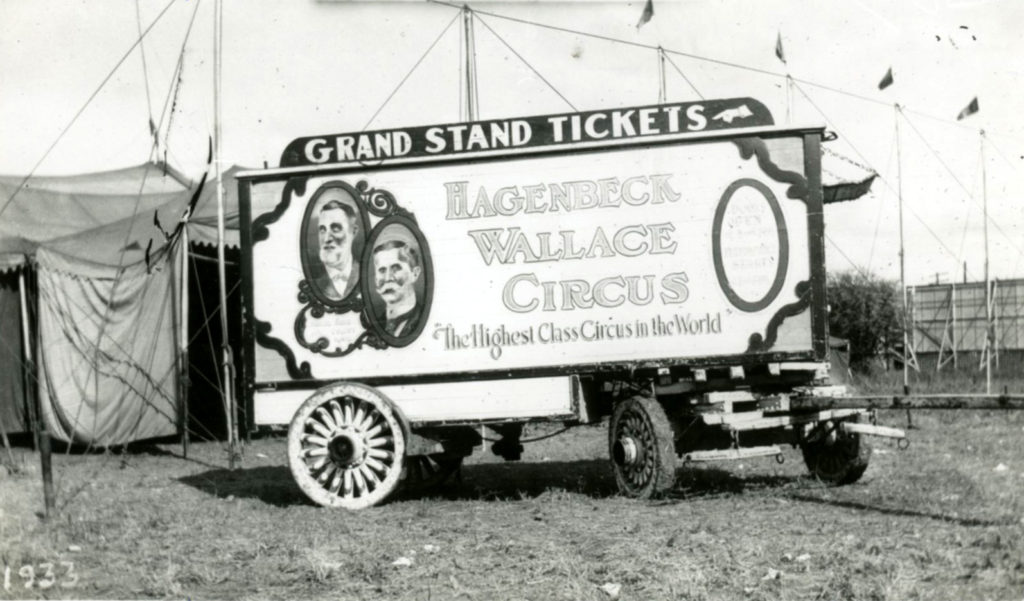 (1933 – Joseph Bradbury Album # 31 – photo # 35D – HW in San Antonio, TX. on Monday Oct. 16, 1933 – Scaperlanda Bros. photo )
(1933 – Joseph Bradbury Album # 31 – photo # 35D – HW in San Antonio, TX. on Monday Oct. 16, 1933 – Scaperlanda Bros. photo )
Emmett Kelly was a cartoonist before he ever became a circus performer. With his artistic abilities, he re-painted this wagon for the 1934 season. Affectionately known as “Mouseville” the painting was done on a canvas covering placed on the side of the wagon. The Mickey Mouse Circus was on the other side of the wagon, also painted by Emmett Kelly. A carved skyboard was added to the wagon along with some carvings in the drop frame and a post type carving on both ends of the sides. All of this was done to enhance the wagon with the addition of the huge street parade for the 1934 season.
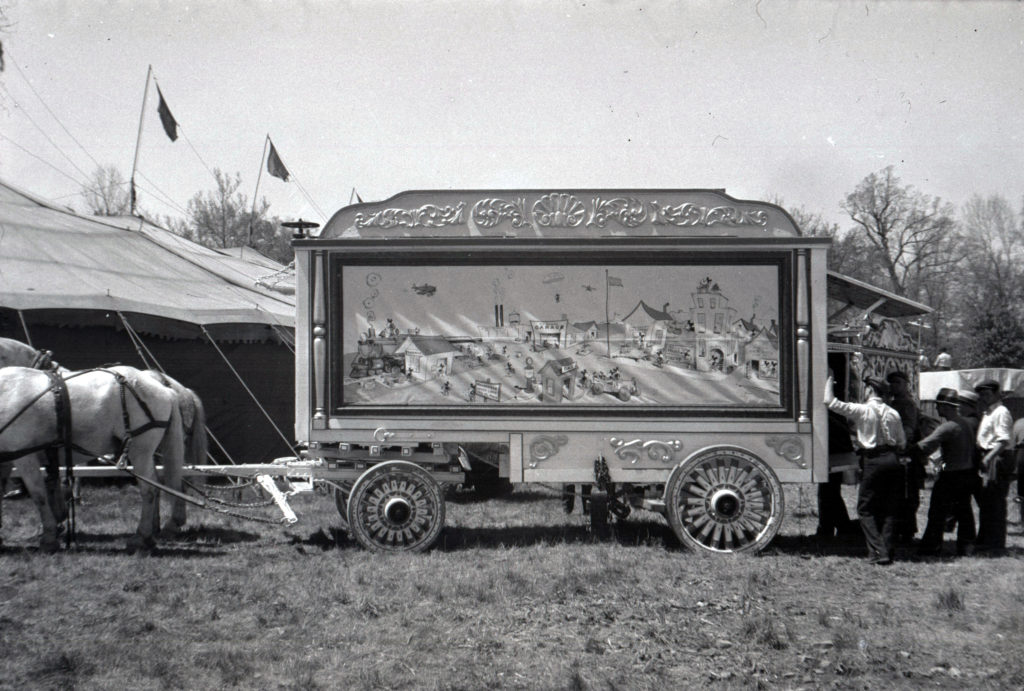 ( 1934 – Conover Set # 926 – photo # 701 )
( 1934 – Conover Set # 926 – photo # 701 )
The decision by the Ringling organization to keep some of the show titles in their possession from being used by anyone prompted them to add the Forepaugh and Sells Bros. to the title for the 1935 season. The wagon was repainted once again, this time by adding all five “owners” portraits to the center of the wagon. The skyboard was changed back to a plain piece being lettered for the Reserved Seat Tickets. The carvings on the drop frame remained as did the post type carving at front and back.
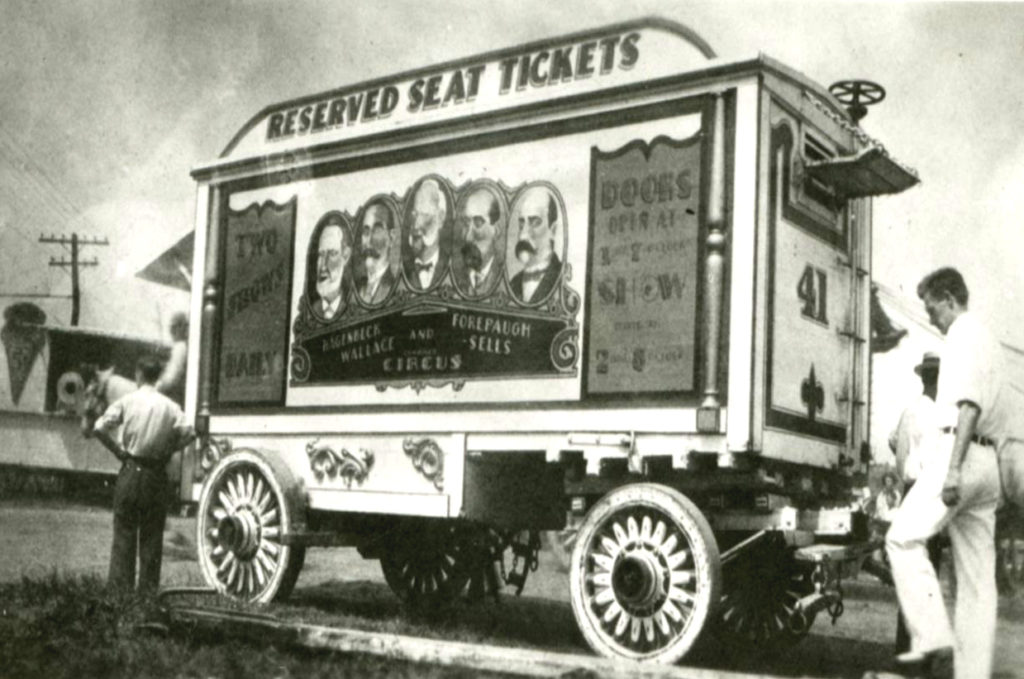 ( 1935 – Conover set # 302 – photo # 222 – Kenneth Whipple collection )
( 1935 – Conover set # 302 – photo # 222 – Kenneth Whipple collection )
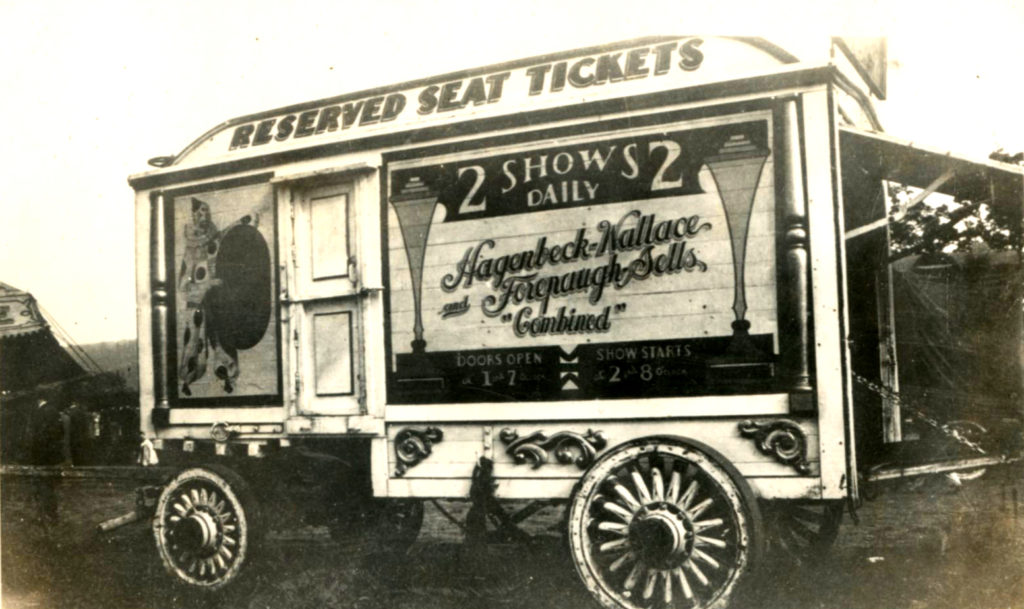 ( 1935 – Joseph Bradbury Album # 31 – photo # 16A – shows the other side of the wagon with the entry door. )
( 1935 – Joseph Bradbury Album # 31 – photo # 16A – shows the other side of the wagon with the entry door. )
In 1935, the side entrance door is cut into the wagon and ready for the 1935 season. This would change the way the sides were decorated over the next few years. None of the Corporation shows left the Peru winter quarters in 1936. By 1937, the wagon was repainted again with Seals balancing balls on the wagon sides.
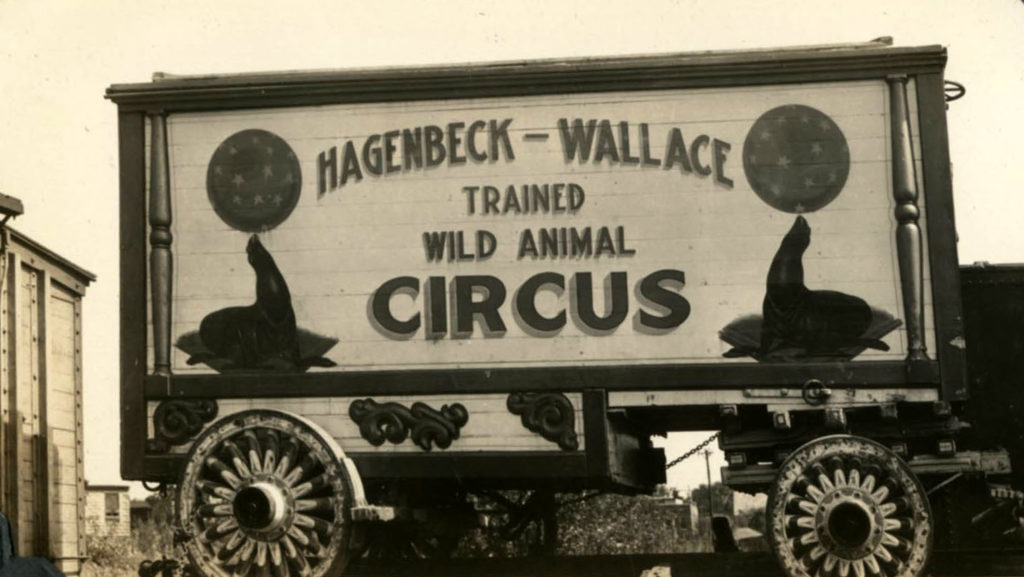 ( 1937 – Joseph Bradbury Album # 64 – photo # 12A – HW – August 8, 1937 in Norfolk, VA. )
( 1937 – Joseph Bradbury Album # 64 – photo # 12A – HW – August 8, 1937 in Norfolk, VA. )
In 1938, the Hagenbeck-Wallace Circus brought in a new Hypnotist act, simply called Blacaman. His performance consisted of working with exotic animals such as Alligators, snakes and wild animals. Once the show folded out on the West Coast, it went to the former Al G. Barnes Circus winter quarters. It was re-organized for the 1939 season as the Great American Circus. That operation also folded prematurely.
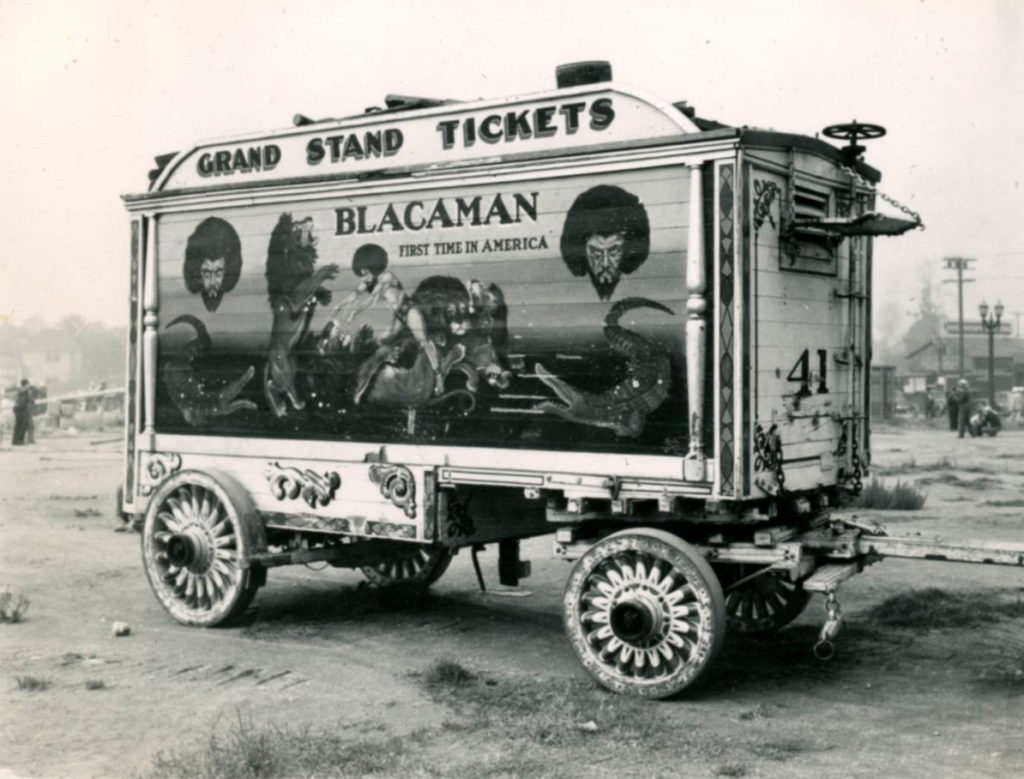 ( 1938 – Joseph Bradbury Album # 31 – photo # 22C – HW in Los Angeles, CA. on Sept. 2, 1938 – Charles Puck photo )
( 1938 – Joseph Bradbury Album # 31 – photo # 22C – HW in Los Angeles, CA. on Sept. 2, 1938 – Charles Puck photo )
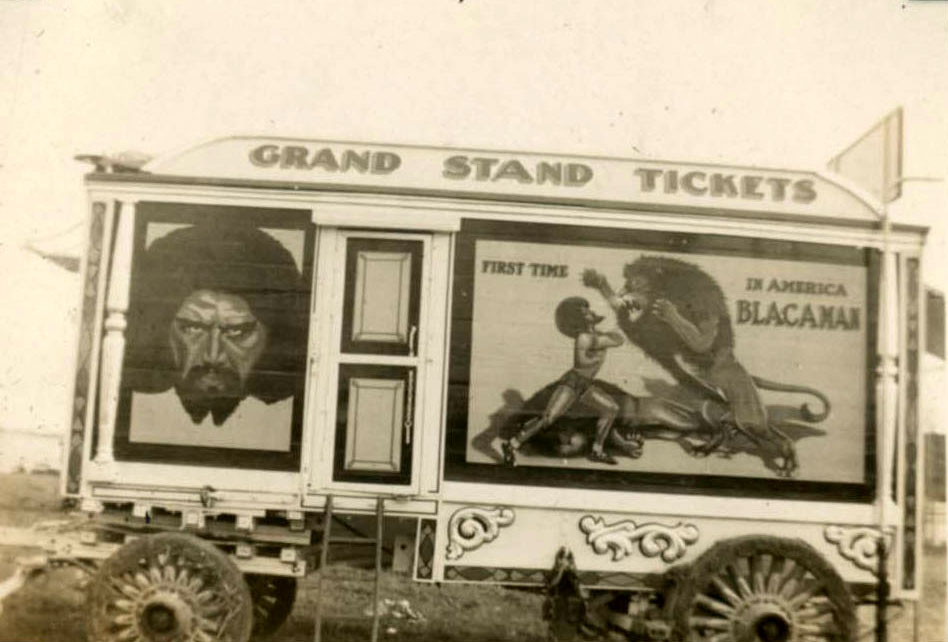 ( 1938 – Joseph Bradbury Album # 64 – photo # 30D – HW at Peru Opening )
( 1938 – Joseph Bradbury Album # 64 – photo # 30D – HW at Peru Opening )
This wagon went out again in 1939 as part of the Great American Circus that failed miserable as well. With the liquidation of the Hagenbeck-Wallace assets by the Ringling organization, movie prop dealer and animal compound owner, Louis Goebel, received a number of animals wagons and props for relatively little to nothing. Having sat idle at Louis Goebel’s World Jungle Compound near Los Angeles, CA. for several years, Martin Arthur made a deal with Louis Goebel to lease enough wagons to put his Arthur Bros. Circus on rails for the 1945 season. This wagon was repainted with a charging tiger painting. It served the show as the Reserved Seating Ticket Wagon. The show closed at the end of their season and the wagons all went back to Louis Goebel’s place.
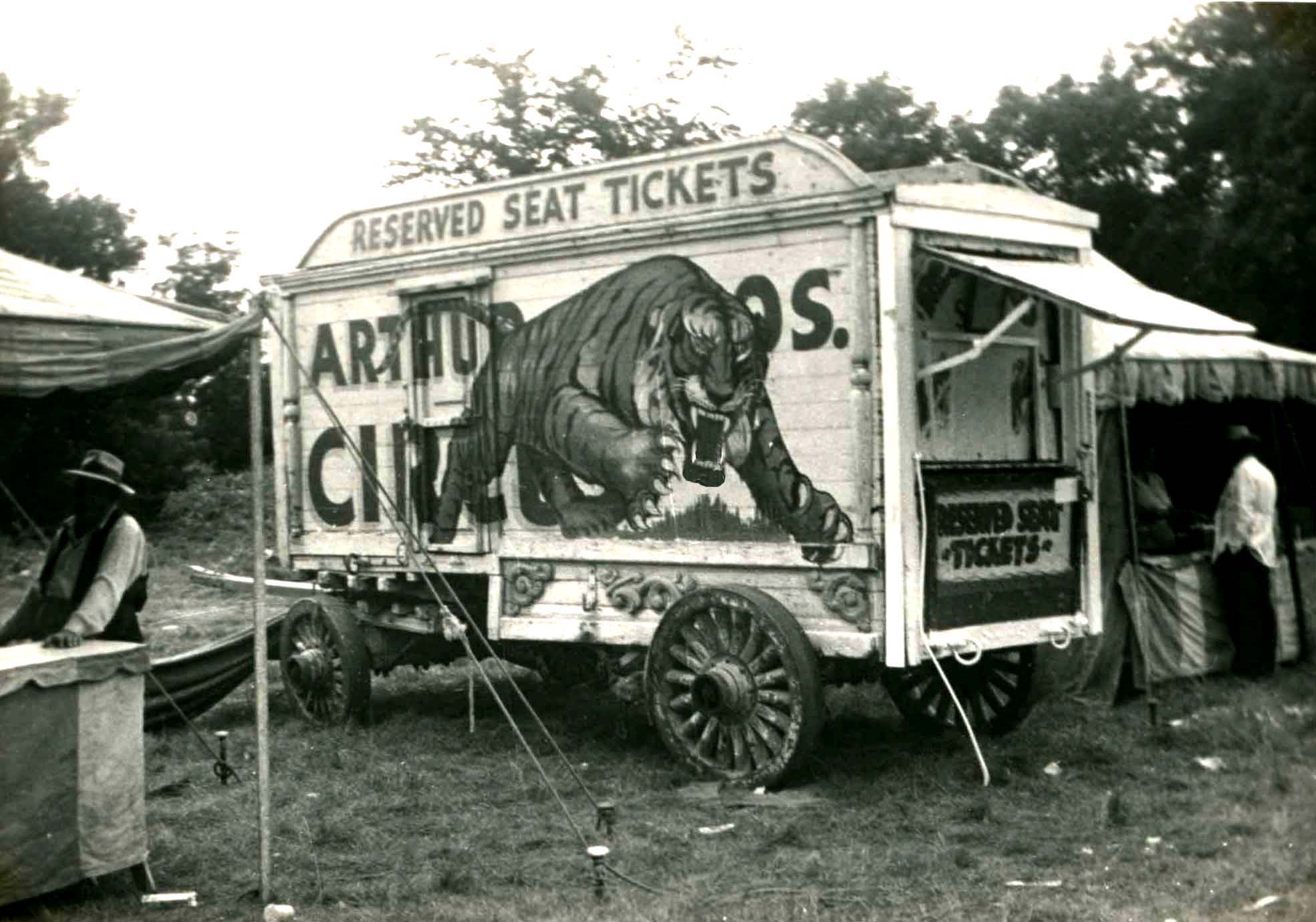 ( 1945 – Joseph Bradbury Album # 78 – photo # 33A – Arthur Bros. Circus as seen in Fon du Lac, WI. on July 28, 1945 – Cliff F. Cowen photo )
( 1945 – Joseph Bradbury Album # 78 – photo # 33A – Arthur Bros. Circus as seen in Fon du Lac, WI. on July 28, 1945 – Cliff F. Cowen photo )
The wagon was only used for the 1945 season before Arthur bros. Circus folded. All of the equipment was returned to the Louis Goebel property where it sat for years. Occasionally a wagon was used in a movie as a prop. Here is what it looked like a couple years after being used in a movie.
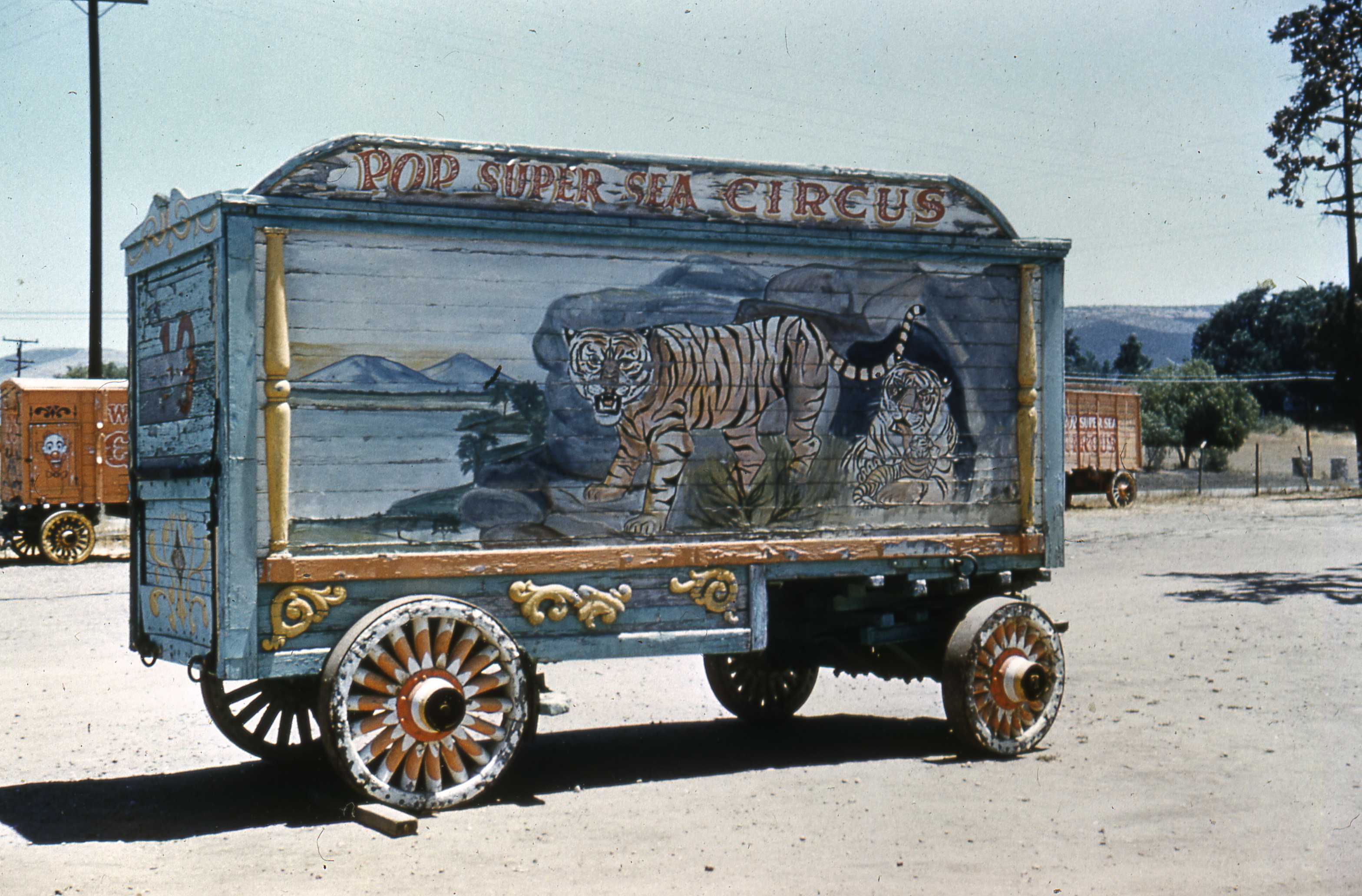
( 1961 – Used as a Movie prop while stored at World Jungle Compound in Los Angeles, CA. – William Lerche photo )
In 1963, Louis Goebel donated this wagon to the Circus World Museum where it was restored several times. The first time it was painted red with some cartoon characters on it. It was numbered # 74.
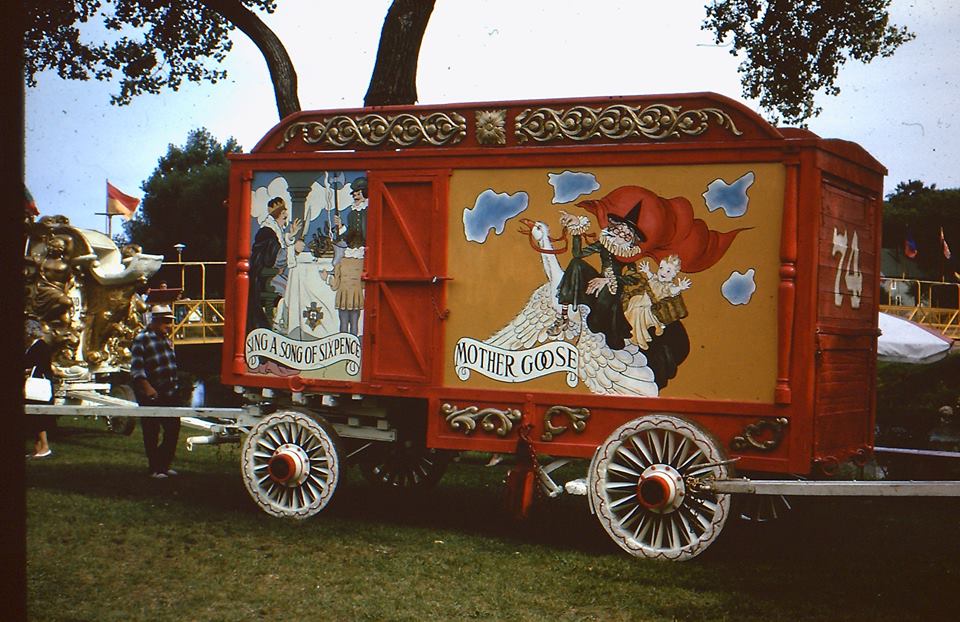 ( 1965 at Circus World Museum – Steve Flint photo )
( 1965 at Circus World Museum – Steve Flint photo )
By 1967, it had been re-painted as the 1945 Arthur Bros. “Charging Tiger” tableau. The pouncing tiger rendition was patterned off of a 1915 circus poster featuring the artwork of Charles Livingston Bull. It has since been repainted again with a different charging tiger version.
 ( 2007 – Bob Cline photo )
( 2007 – Bob Cline photo )
The wagon is 17’8″ long x 11’0″ tall x 8’2″ wide. it weighs 9,350 pounds.
The wagon can be seen in person at Circus World in Baraboo, Wisconsin
If you have any questions or have more photographic evidence, feel free to contact us at circuswagons@gmail.com
